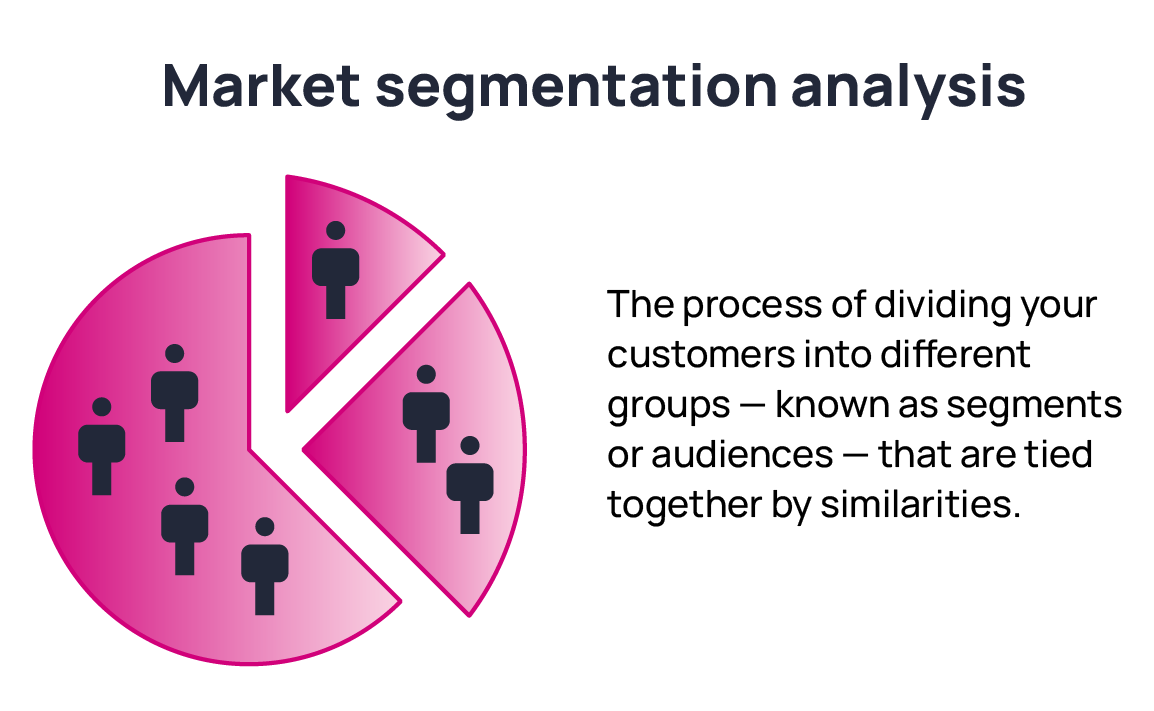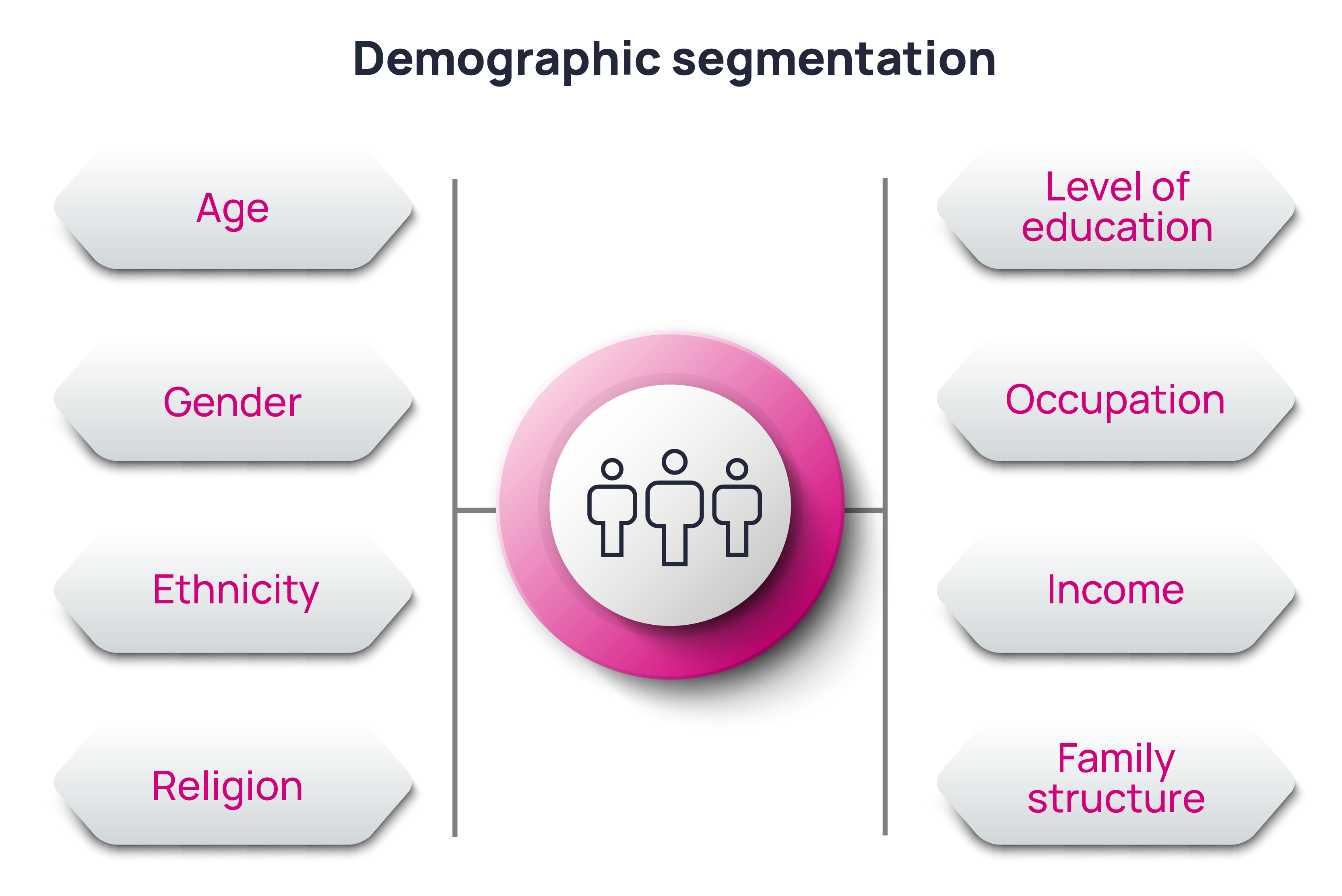The ultimate guide to market segmentation analysis
The world runs on data. Because of that, there’s more than one way to slice the pie when it comes to market segmentation analysis.
By now, you’re probably aware that segmentation analysis is yet another way to draw insights from your customer data to drive better marketing campaigns by building more complete customer profiles. In other words, it helps you meet your customers wherever they are on their customer journey.
With market segmentation analysis on hand, you’re able to provide a personalized experience to an ever-demanding customer base. When done right, it's a great way to make data-driven marketing decisions that yield results capable of driving revenue.
Not sure where to start? This guide will walk you through the ins and outs of market segmentation analysis including the different types of analyses, the benefits, and how you can get started.
What is market segmentation analysis?
Market segmentation analysis is the process of dividing your customers into different groups — known as segments or audiences — that are tied together by similarities.
This grouping makes it easier for you to make decisions about targeting and positioning your products and services and can even empower you to have multiple messaging strategies depending on which segments you are addressing at any given time.

There are several different methods for market segmentation analysis, but the most common approach is to use demographic information such as age, gender, location, or income. Other approaches include segmenting customers by their interests, needs, beliefs, or behaviors.
Once you’ve identified your target markets, you can start developing marketing strategies based on segmentation analyses tailored to each of those groups. This way, you can align marketing channels, the audience, and their goals with higher precision.
Pretty straightforward, right? Not completely — market segmentation analysis can be a complex process. But if your business is interested in maximizing results with the resources you have on hand, it’s a must.
Simply put, without segmentation analysis, it’s harder to make data-driven decisions that help marketers target their audiences effectively.
Benefits of market segmentation analysis
Running a market segmentation analysis helps marketers drive more value. Perhaps the most important benefit is that your business can focus its resources on the most promising segments of your market, or get a better feel for who your audience actually is. As a result, you see an increase in sales and customer satisfaction.

Some other ways that market segmentation analysis can benefit your business include:
- Uncovering new growth opportunities
- Gaining a more unified view of your ideal customer
- Applying data-driven go-to-market strategies
- Mass customization across your audiences within your marketing campaigns
- Achieving higher return on ad spend (ROAS) for your paid media campaigns
- Securing a better understanding of changing marketing trends
- Appealing to real customer needs, market gaps, and pain points
- Developing new products, features, and services that’ll appeal to each segment
- Increasing your bottom line with better resource management
That’s a long list of benefits —and we could go on. But the bottom line is that any data-driven business looking to optimize its efforts would be remiss not to focus on segmentation analysis as part of its larger marketing plan. To do that though, it’s important to become familiar with the types of analyses you can run.
The types of market segmentation analysis

There are generally four types of B2C market segmentation analysis:
- Geographic segmentation
- Psychographic segmentation
- Demographic segmentation
- Behavioral segmentation
But there are other types of segmentation as well. Let’s dive in.
Geographic segmentation
Geographic segmentation looks at where customers live or work. You can then use that data to target marketing campaigns, specifically to certain geographic areas that are most likely to result in sales.

For example, a business selling snowboards would want to focus its marketing efforts in areas with high levels of winter tourism or where there is reliable snowfall throughout the season.
Psychographic segmentation
Psychographic segmentation looks at a population’s psychological characteristics, including values, attitudes, interests, and lifestyles.

You can use this type of analysis to identify customer needs and desires that are not always apparent through demographic data alone. For example, a customer interested in buying luxury cars may also be interested in other high-end products and services.
Demographic segmentation
Demographic segmentation looks at a population’s characteristics, such as age, gender, income level, or occupation.

Understanding these demographics helps businesses better target their marketing campaigns and products/services to appeal to specific groups of people. A company selling baby products may want to focus its marketing efforts on new parents within a particular age bracket, like 25-34.
Behavioral segmentation
Behavioral segmentation looks at how customers behave when making purchasing decisions. Factors such as purchase frequency, product usage, and brand loyalty, are included. Understanding these behaviors helps businesses tailor their marketing campaigns and strategies to better meet the needs of their target customers.

A business selling mobile phones would want to focus its marketing efforts on customers who frequently upgrade to the latest model or those who are loyal to a particular brand.
Other types of segmentation
While the four types of segmentation above are the most common types, that doesn’t mean there aren’t other ways that you can split up your customers. You can also segment your customers based on:
- Lifecycle: Where they are in the customer lifecycle
- Buyer’s journey stage: Which stage of the buyer’s journey they are in
- Persona: Which buyer persona they best represent (if you deal with multiple personas)
- and more
Remember, the groupings above are not set in stone. Don’t be afraid to get creative when designing your segments.
How to get started with market segmentation analysis
First, businesses should identify their overall goals for a market segmentation analysis. What does the business hope to achieve by conducting this type of analysis? Is the goal conversions, brand awareness, or something else entirely?
Once your marketing goals are clear, it’s time to gather data on your target market. This is where a customer data platform (CDP) makes it easy to gather zero-, first-, or third-party customer data with fewer bottlenecks.

A segmentation analysis usually consists of a few general steps that can be divided into phases, including segmenting, targeting, and positioning. These phases are as follows:
- Outline who your target market is: Don’t launch segmentation blindfolded. Clearly define your Ideal Customer Profile (ICP). Who are you trying to reach? What are their pain points and desires? What do they care about?
- Analyze your existing customer base: Now it’s time to get acquainted with the customer data you already have. Analyze existing customer information to identify patterns and potential segments.
- Create buyer personas: Go beyond demographics by crafting detailed buyer personas that paint a vivid picture of your ideal customers, including what motivates them, their behaviors, and their challenges.
- Identify gaps, groups, and opportunities to target: Now that you’ve analyzed your data, review your findings. Are there underserved customer groups or unmet needs? Identifying these gaps unveils potential target customers for future growth.
- Research and define each segment: Sharpen your focus by defining each customer segment with clear criteria based on your research, customer data, and findings. This allows you to tailor messaging and marketing strategies for maximum impact.
- Test and optimize: Segmentation (and segmentation analysis) is an ongoing process. Here’s where marketers get to experiment! Test your strategies, analyze the results, and optimize your segments for continuous improvement. Remember: the best marketing is always personalized and data-driven!
After you have segmented your target market, you can begin analyzing each segment. You should look at factors such as size, needs, and potential growth of the segment. Through marketing efforts, businesses identify which segments are most promising and worth targeting.
AI for market segmentation
In traditional market segmentation, there is a human insight that ultimately informs and drives what a particular segment looks like. Someone on your marketing team recognized the fact that people who share certain characteristics behave similarly and then set about creating a segment to capture that audience — whether that is driven by demographics, geography, purchasing behavior, etc.
But today, segmentation doesn’t need to rely solely on human pattern prediction or assumptions. Artificial intelligence (AI) and machine learning (ML) offer potentially quicker and more efficient means of identifying and predicting valuable segments, and can even identify patterns in your customer data that would be difficult — if not impossible — for a human to recognize.
Learn more about how Simon Data can support predictive segmentation for your business.
Examples of segmentation analysis
Let’s look at some examples of how a segmentation analysis can help you uncover valuable insights for better marketing results.
1. Use customer data to segment your target market
One way to use customer data in a segmentation analysis is to segment your target market according to various criteria. This can include the following criteria:
- Customers on your newsletter who haven’t made a purchase yet
- Specific customer timestamps
- Dates
- Numeric values
- Boolean values
- Statuses (active, canceled, expired)
- Any promo codes used to make a purchase
Once you have these segments identified, you can work to create messaging, promotions, ads, and other creatives tailored to each. A/B testing can be especially helpful here.
2. Segment your customer base by purchase history
Another way to use customer data in a segmentation analysis is to segment your customer base by purchase history or action. This can help you identify your most valuable customers, set up remarketing campaigns, and use a lifecycle marketing approach to continue to keep repeat buyers.
For example, you might use segmentation to create audiences like:
- Abandoned carts, who can then be served marketing emails with gentle nudges to return and complete their purchase
- Repeat purchasers, who may indicate a particularly valuable subset of your customer base that should be nurtured
- Non-repeat purchasers, who may not be aware of your full offerings and be served messaging that helps them become aware of those other options
- Non-active buyers, who haven’t made a purchase in a certain amount of time and may be lured back with a promo code or some other incentive
3. Use customer data to segment your target market by demographics
A further way to use customer data in a segmentation analysis is to segment your target market by demographics.
What if you want to target adults between the ages of 20-40 who love the Disney brand and live in Florida and California? With a demographic target segmentation, you’re able to target that specific group of people. And the more criteria with which you can narrow down your target audience, the better your chances of getting optimal results.
Run better analyses with the Simon Data CDP
CDP solutions like Simon Data make it easy for your marketers to segment their market and save and name each segment. With its sophisticated segmentation logic, you’re able to segment your audience with plenty of criteria for GTM motions like email marketing campaigns, brand awareness campaigns, and retargeting strategies.
By using Simon Data, you can get a complete picture of your target market and identify growth opportunities. You can fine-tune and automate workflows, including customer segmentation analysis. Businesses use Simon Data to collect data from multiple sources, including online and offline channels, social media, CRM systems, and transactional data.
It’s one thing to hear about it — and it’s another to see it in action. Our world-class CDP helps you unlock and manage the insights hidden in your data. Request a Simon Data demo today.



.webp)
